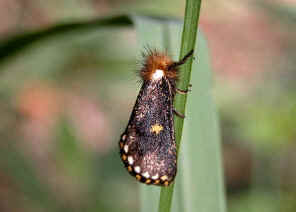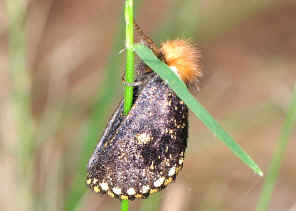Brown Ring Epicoma Moth - Epicoma tristis
Family NOTODONTIDAE
This page contains pictures and information about Brown Ring Epicoma Moths that we found in the Brisbane area, Queensland, Australia.

- Wingspan 30mm
- The moth's forewings are dark brown in colour, with a row of creamy and another row of yellow spots along the wing edges. At the middle of its forewings there is a dark ring with a yellow dot.



- First picture was taken in Wishart Outlook along Bulimba Creek during mid summer. Second picture was taken On White Hill during early winter, when the moth was sun-bathing on a wattle tree. For this species male and female are looked similar.



- January, early instars length 15mm
- The Caterpillars are dark grey with short hair. They usually found feed in group, may be seen in procession. Their host plants include gum tree.



- January, mid instars length 20mm
- Early to mid instars feed and rest together in small group.


- February, mid instars length 30mm
- Feb 2008, Karawatha Forest, Lagoon



- February, late instars length 40mm
- Later instars are solitary. They feed and rest alone. Occasionally they may be seen grouping together in procession, follow each other moving along the silk threads left by the caterpillars in front. They pupate in soil.
- We are not sure if all the caterpillars shown in this page are exactly the Brown Ring Epicoma Moth larvae, they look very close anyway. Caterpillar of genus Epicoma are hard to be distinguished unless rearing them to see the adult moth.
- The moth are quite common in Brisbane bushlands. There were usually found resting on plants openly during the day.



-



-



- Reference:
- 1. Epicoma tristis - Australia Moths Online, 2007.
- 2. Epicoma tristis - Caterpillars of Australian NOTODONTIDAE, by Don Herbison-Evans & Stella Crossley, 2007.
- 3. Moths of Australia - I. F. B. Common, Melbourne University Press, 1990, p425.
